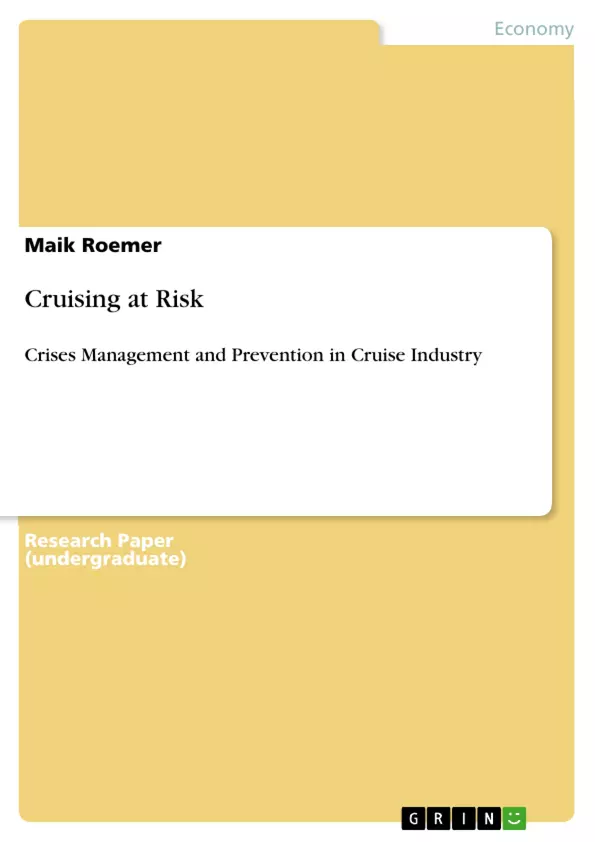This study will show different risks on cruise vacations and within the cruise industry. The study will show past, present and future challenges for risk management and the important role of media for keeping up the boom in cruise vacations. Cruise vessels will be identified as potential targets for terroristic violence and the public prevention via media will be shown.
Is an ocean voyage safe or is there just a feeling of safety?
To approximate the topic it will be given important definitions and an overview about the historic development with historic ‚points of change’ within the cruise industry. The risk for ocean liners will be identified and categorized. It will be given an overview about historic development of safety regulations in ocean cruising and the role of media
Inhaltsverzeichnis (Table of Contents)
- Goal and approach of this Study
- Introduction
- Definitions
- Cruise ship
- Cruise
- Piracy
- Terrorism
- Crisis
- Risks for cruise vessels
- Inside risks
- Hygienic conditions
- Drugs and crime
- Fire
- Outside risk
- Natural forces
- Piracy
- Terrorism
- Cruise vessels
- Value as Target
- For pirates
- Examples for pirate attacks on vessels
- For terrorists
- Examples for terrorists acts on vessels
- Security
- Short History linked with media
- Passive security
- Active security
- History
- After 9/11
- Management of crises prevention
- Marketing security
- Marketing mix
- Price
- Place
- Product Process
- Product People
- Product physical evidence
- Promotion
- Final remarks
- Future
Zielsetzung und Themenschwerpunkte (Objectives and Key Themes)
This study delves into the various risks associated with cruise vacations and the cruise industry. It explores past, present, and future challenges in risk management, highlighting the crucial role of media in maintaining the cruise industry's boom. Cruise vessels are identified as potential targets for terroristic violence, and the public prevention through media is examined. The study seeks to determine if an ocean voyage offers true safety or merely a feeling of security.
- Risks associated with cruise vacations and the cruise industry
- Challenges in risk management and prevention
- The role of media in promoting and shaping perceptions of cruise travel
- Cruise vessels as potential targets for terrorism and the importance of public awareness
- Historical development and current trends in safety regulations within the cruise industry
Zusammenfassung der Kapitel (Chapter Summaries)
The study begins by defining key terms related to cruise vacations, including cruise ships, cruises, piracy, terrorism, and crisis management. It then analyzes the various risks faced by cruise vessels, both internal and external, such as hygienic conditions, drug and crime activity, fire, natural forces, piracy, and terrorism. The study discusses the potential value of cruise vessels as targets for pirates and terrorists, examining historical examples of attacks and acts of violence. The role of security in the cruise industry is then explored, including its historical development and the evolution of security measures after the September 11th attacks. Finally, the study investigates strategies for managing and preventing crises in the cruise industry, focusing on marketing security and the importance of promoting a sense of safety and security to potential travelers.
Schlüsselwörter (Keywords)
The study focuses on key terms such as cruise vacations, risk management, crisis prevention, security, piracy, terrorism, media, and public perception. It explores the historical development of the cruise industry and examines the impact of events like the September 11th attacks on travel behavior and security measures. The study highlights the importance of promoting a sense of safety and security to maintain the popularity of cruise travel, while acknowledging the potential risks and challenges associated with this industry.
- Quote paper
- Maik Roemer (Author), 2008, Cruising at Risk, Munich, GRIN Verlag, https://www.grin.com/document/161012



